Yu Fan
Kimi K2: Open Agentic Intelligence
Jul 28, 2025Abstract:We introduce Kimi K2, a Mixture-of-Experts (MoE) large language model with 32 billion activated parameters and 1 trillion total parameters. We propose the MuonClip optimizer, which improves upon Muon with a novel QK-clip technique to address training instability while enjoying the advanced token efficiency of Muon. Based on MuonClip, K2 was pre-trained on 15.5 trillion tokens with zero loss spike. During post-training, K2 undergoes a multi-stage post-training process, highlighted by a large-scale agentic data synthesis pipeline and a joint reinforcement learning (RL) stage, where the model improves its capabilities through interactions with real and synthetic environments. Kimi K2 achieves state-of-the-art performance among open-source non-thinking models, with strengths in agentic capabilities. Notably, K2 obtains 66.1 on Tau2-Bench, 76.5 on ACEBench (En), 65.8 on SWE-Bench Verified, and 47.3 on SWE-Bench Multilingual -- surpassing most open and closed-sourced baselines in non-thinking settings. It also exhibits strong capabilities in coding, mathematics, and reasoning tasks, with a score of 53.7 on LiveCodeBench v6, 49.5 on AIME 2025, 75.1 on GPQA-Diamond, and 27.1 on OJBench, all without extended thinking. These results position Kimi K2 as one of the most capable open-source large language models to date, particularly in software engineering and agentic tasks. We release our base and post-trained model checkpoints to facilitate future research and applications of agentic intelligence.
The Medium Is Not the Message: Deconfounding Text Embeddings via Linear Concept Erasure
Jul 01, 2025Abstract:Embedding-based similarity metrics between text sequences can be influenced not just by the content dimensions we most care about, but can also be biased by spurious attributes like the text's source or language. These document confounders cause problems for many applications, but especially those that need to pool texts from different corpora. This paper shows that a debiasing algorithm that removes information about observed confounders from the encoder representations substantially reduces these biases at a minimal computational cost. Document similarity and clustering metrics improve across every embedding variant and task we evaluate -- often dramatically. Interestingly, performance on out-of-distribution benchmarks is not impacted, indicating that the embeddings are not otherwise degraded.
Can Large Language Models Capture Human Annotator Disagreements?
Jun 24, 2025Abstract:Human annotation variation (i.e., annotation disagreements) is common in NLP and often reflects important information such as task subjectivity and sample ambiguity. While Large Language Models (LLMs) are increasingly used for automatic annotation to reduce human effort, their evaluation often focuses on predicting the majority-voted "ground truth" labels. It is still unclear, however, whether these models also capture informative human annotation variation. Our work addresses this gap by extensively evaluating LLMs' ability to predict annotation disagreements without access to repeated human labels. Our results show that LLMs struggle with modeling disagreements, which can be overlooked by majority label-based evaluations. Notably, while RLVR-style (Reinforcement learning with verifiable rewards) reasoning generally boosts LLM performance, it degrades performance in disagreement prediction. Our findings highlight the critical need for evaluating and improving LLM annotators in disagreement modeling. Code and data at https://github.com/EdisonNi-hku/Disagreement_Prediction.
LEXam: Benchmarking Legal Reasoning on 340 Law Exams
May 19, 2025

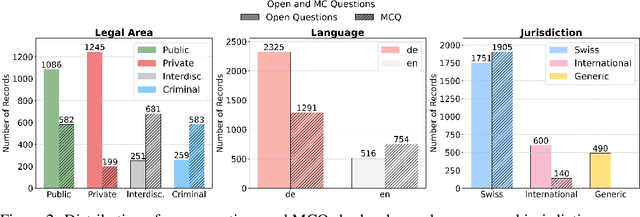
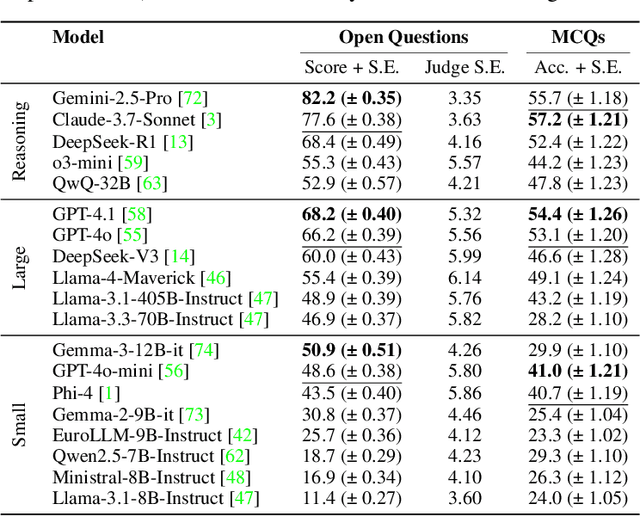
Abstract:Long-form legal reasoning remains a key challenge for large language models (LLMs) in spite of recent advances in test-time scaling. We introduce LEXam, a novel benchmark derived from 340 law exams spanning 116 law school courses across a range of subjects and degree levels. The dataset comprises 4,886 law exam questions in English and German, including 2,841 long-form, open-ended questions and 2,045 multiple-choice questions. Besides reference answers, the open questions are also accompanied by explicit guidance outlining the expected legal reasoning approach such as issue spotting, rule recall, or rule application. Our evaluation on both open-ended and multiple-choice questions present significant challenges for current LLMs; in particular, they notably struggle with open questions that require structured, multi-step legal reasoning. Moreover, our results underscore the effectiveness of the dataset in differentiating between models with varying capabilities. Adopting an LLM-as-a-Judge paradigm with rigorous human expert validation, we demonstrate how model-generated reasoning steps can be evaluated consistently and accurately. Our evaluation setup provides a scalable method to assess legal reasoning quality beyond simple accuracy metrics. Project page: https://lexam-benchmark.github.io/
TrackRAD2025 challenge dataset: Real-time tumor tracking for MRI-guided radiotherapy
Mar 24, 2025Abstract:Purpose: Magnetic resonance imaging (MRI) to visualize anatomical motion is becoming increasingly important when treating cancer patients with radiotherapy. Hybrid MRI-linear accelerator (MRI-linac) systems allow real-time motion management during irradiation. This paper presents a multi-institutional real-time MRI time series dataset from different MRI-linac vendors. The dataset is designed to support developing and evaluating real-time tumor localization (tracking) algorithms for MRI-guided radiotherapy within the TrackRAD2025 challenge (https://trackrad2025.grand-challenge.org/). Acquisition and validation methods: The dataset consists of sagittal 2D cine MRIs in 585 patients from six centers (3 Dutch, 1 German, 1 Australian, and 1 Chinese). Tumors in the thorax, abdomen, and pelvis acquired on two commercially available MRI-linacs (0.35 T and 1.5 T) were included. For 108 cases, irradiation targets or tracking surrogates were manually segmented on each temporal frame. The dataset was randomly split into a public training set of 527 cases (477 unlabeled and 50 labeled) and a private testing set of 58 cases (all labeled). Data Format and Usage Notes: The data is publicly available under the TrackRAD2025 collection: https://doi.org/10.57967/hf/4539. Both the images and segmentations for each patient are available in metadata format. Potential Applications: This novel clinical dataset will enable the development and evaluation of real-time tumor localization algorithms for MRI-guided radiotherapy. By enabling more accurate motion management and adaptive treatment strategies, this dataset has the potential to advance the field of radiotherapy significantly.
Treating Point Cloud as Moving Camera Videos: A No-Reference Quality Assessment Metric
Aug 30, 2022



Abstract:Point cloud is one of the most widely used digital representation formats for 3D contents, the visual quality of which may suffer from noise and geometric shift during the production procedure as well as compression and downsampling during the transmission process. To tackle the challenge of point cloud quality assessment (PCQA), many PCQA methods have been proposed to evaluate the visual quality levels of point clouds by assessing the rendered static 2D projections. Although such projection-based PCQA methods achieve competitive performance with the assistance of mature image quality assessment (IQA) methods, they neglect the dynamic quality-aware information, which does not fully match the fact that observers tend to perceive the point clouds through both static and dynamic views. Therefore, in this paper, we treat the point clouds as moving camera videos and explore the way of dealing with PCQA tasks via using video quality assessment (VQA) methods in a no-reference (NR) manner. First, we generate the captured videos by rotating the camera around the point clouds through four circular pathways. Then we extract both spatial and temporal quality-aware features from the selected key frames and the video clips by using trainable 2D-CNN and pre-trained 3D-CNN models respectively. Finally, the visual quality of point clouds is represented by the regressed video quality values. The experimental results reveal that the proposed method is effective for predicting the visual quality levels of the point clouds and even competitive with full-reference (FR) PCQA methods. The ablation studies further verify the rationality of the proposed framework and confirm the contributions made by the quality-aware features extracted from dynamic views.
A No-reference Quality Assessment Metric for Point Cloud Based on Captured Video Sequences
Jun 09, 2022



Abstract:Point cloud is one of the most widely used digital formats of 3D models, the visual quality of which is quite sensitive to distortions such as downsampling, noise, and compression. To tackle the challenge of point cloud quality assessment (PCQA) in scenarios where reference is not available, we propose a no-reference quality assessment metric for colored point cloud based on captured video sequences. Specifically, three video sequences are obtained by rotating the camera around the point cloud through three specific orbits. The video sequences not only contain the static views but also include the multi-frame temporal information, which greatly helps understand the human perception of the point clouds. Then we modify the ResNet3D as the feature extraction model to learn the correlation between the capture videos and corresponding subjective quality scores. The experimental results show that our method outperforms most of the state-of-the-art full-reference and no-reference PCQA metrics, which validates the effectiveness of the proposed method.
Hyper-Sphere Quantization: Communication-Efficient SGD for Federated Learning
Nov 25, 2019



Abstract:The high cost of communicating gradients is a major bottleneck for federated learning, as the bandwidth of the participating user devices is limited. Existing gradient compression algorithms are mainly designed for data centers with high-speed network and achieve $O(\sqrt{d} \log d)$ per-iteration communication cost at best, where $d$ is the size of the model. We propose hyper-sphere quantization (HSQ), a general framework that can be configured to achieve a continuum of trade-offs between communication efficiency and gradient accuracy. In particular, at the high compression ratio end, HSQ provides a low per-iteration communication cost of $O(\log d)$, which is favorable for federated learning. We prove the convergence of HSQ theoretically and show by experiments that HSQ significantly reduces the communication cost of model training without hurting convergence accuracy.
Can Image Enhancement be Beneficial to Find Smoke Images in Laparoscopic Surgery?
Dec 27, 2018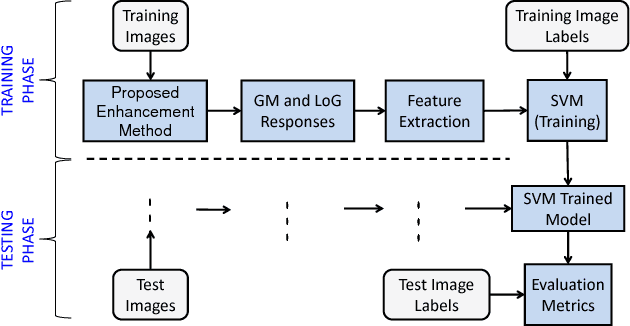
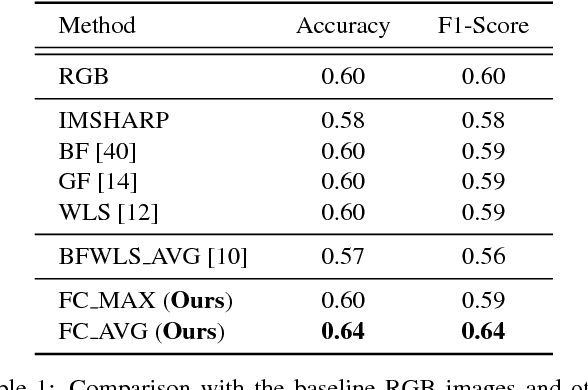
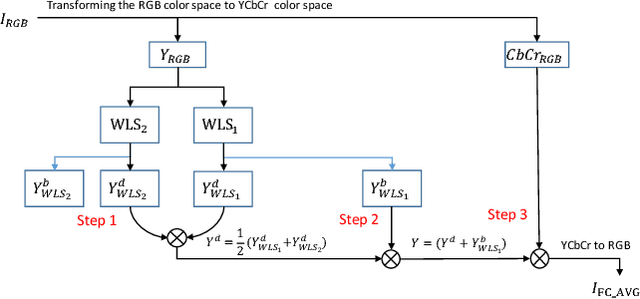
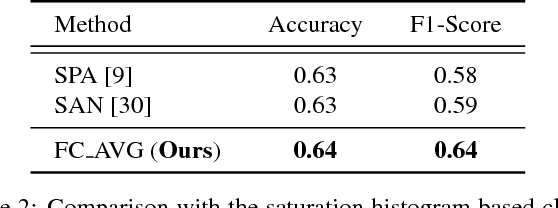
Abstract:Laparoscopic surgery has a limited field of view. Laser ablation in a laproscopic surgery causes smoke, which inevitably influences the surgeon's visibility. Therefore, it is of vital importance to remove the smoke, such that a clear visualization is possible. In order to employ a desmoking technique, one needs to know beforehand if the image contains smoke or not, to this date, there exists no accurate method that could classify the smoke/non-smoke images completely. In this work, we propose a new enhancement method which enhances the informative details in the RGB images for discrimination of smoke/non-smoke images. Our proposed method utilizes weighted least squares optimization framework~(WLS). For feature extraction, we use statistical features based on bivariate histogram distribution of gradient magnitude~(GM) and Laplacian of Gaussian~(LoG). We then train a SVM classifier with binary smoke/non-smoke classification task. We demonstrate the effectiveness of our method on Cholec80 dataset. Experiments using our proposed enhancement method show promising results with improvements of 4\% in accuracy and 4\% in F1-Score over the baseline performance of RGB images. In addition, our approach improves over the saturation histogram based classification methodologies Saturation Analysis~(SAN) and Saturation Peak Analysis~(SPA) by 1/5\% and 1/6\% in accuracy/F1-Score metrics.
Learning Continuous-Time Social Network Dynamics
May 09, 2012



Abstract:We demonstrate that a number of sociology models for social network dynamics can be viewed as continuous time Bayesian networks (CTBNs). A sampling-based approximate inference method for CTBNs can be used as the basis of an expectation-maximization procedure that achieves better accuracy in estimating the parameters of the model than the standard method of moments algorithmfromthe sociology literature. We extend the existing social network models to allow for indirect and asynchronous observations of the links. A Markov chain Monte Carlo sampling algorithm for this new model permits estimation and inference. We provide results on both a synthetic network (for verification) and real social network data.
 Add to Chrome
Add to Chrome Add to Firefox
Add to Firefox Add to Edge
Add to Edge